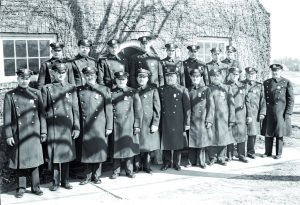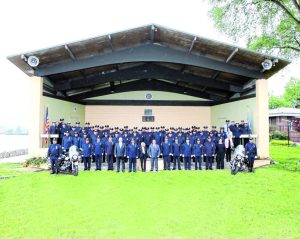
The year was 1921. On the global level, President Warren Harding declared an end to America’s state of war with Germany, Austria and Hungary. Simultaneously the 18th Amendment to the U.S. Constitution, which banned the manufacture, transportation and sale of intoxicating liquors, ushered in a period in American history known as Prohibition.
Up until that time, however, all was well in a small, north shore town on Long Island called Port Washington (population 6,000) where a constable named Frederick Snow patrolled the streets of the idyllic enclave doing the best he could as the town’s lone law officer.
As most towns began to grow in the New York City suburbs, Port Washington’s population started to show signs of rapid growth due to the increased use of the Long Island Railroad line and other factors such as automobile use. It became impossible for one man to work around the clock seven days a week and give the community proper police protection.
The time had finally come that a larger, more adequate police force was needed.
At the urging of residents, and with the assistance of local politicians, a bill was introduced in 1921 in the State Legislature in Albany to create a “Police District” in Port Washington. The district, created as an organization with power to tax, is the last such district on the Island and in the state of New York. It was established to serve residents in the unincorporated area of Port Washington and the villages of Port Washington North and Baxter Estates. The Police District is governed by three commissioners (Port Washington residents) who are elected for three-year terms. Although Civil Service guidelines regulate hiring, the commissioners regulate departmental procedures.
After passage of the bill, the Port Washington Police District was established and began official operation on Jan. 1, 1922, Frederick Snow became the first Police Chief lasting until 1925 when the Port Washington Police Commissioners appointed New York City retired Police Captain Philip N. Grosbeck. The commissioners hoped Grosbeck would bring city police methods to Port Washington.
During these early years, the remainder of the department consisted of a day clerk and a night clerk, who acted as desk officers. These civilian employees worked 12 hour shifts. There were six men on the force, one lieutenant and five patrolmen. The force worked without days off but was allowed 10 days of vacation a year. This small force was required to turn out all men for every general alarm fire regardless of tour worked. The yearly salary for Port Washington Patrolmen was $1,500.
The five patrolmen were given bicycles for patrolling and answering calls. The chief and the lieutenant were given a model T Ford to ride in. The only means of contacting the patrolmen was by a green lighted lamp hung over each call box. These boxes were placed throughout the village, including the residential district. The village, at this point in time, was still a beautiful rural town. Traffic was just a trickle and horses were still drawing milk wagons.
In 1928, Chief Grosbeck retired and Stephen J. Webber, a former Army Provost Marshal at Mitchel Field, was appointed chief. He headed the department for fourteen years, during which time the size of the force increased to 20 men. Radios were added to patrol cars, receivers only at first, with acknowledgment over the nearest call box. Later, two-way radios were installed.
PAL Established
In 1945, the Port Washington Police had the idea of channeling the energy of Port’s youth into “healthy” activities, and the Police Athletic League (P.A.L) was spawned. The program—predominantly softball at the time—was put into action by several police officers, including Lieut. James Salerno, and the building that first housed the Port Washington Police at 325 Main St. at Sunset Park was used as its new home. Today, after extensive renovations, the PAL (renamed “Port Athletic League”) remains a vibrant nonprofit that has grown to include many diverse sports for Port’s youth.
Diversity Comes to the Port Police
In the early sixties, hiring a diverse workforce became a priority to the Port Police, as they recognized it would establish trust between law enforcement and the community. In 1945, the Police District hired the first African American, Tom Brown, who served as the special patrolman for PAL until his retirement in 1953. Ten years later, a second African American, Ronald Pinkney, served the district until 1995. In 1982, the third African American, Brian Staley, was hired and would eventually rise through the ranks as the first African American Lieutenant on the Port Police force and then as deputy chief (a first in Port’s history and Nassau County as well.) Staley forged strong ties with the minority population in Port Washington and during his tenure served as Community liaison to Cow Bay Green (built in the 60’s). He also served as Chairperson of the Economic Opportunity Corp of Nassau County. He retired in 2014 after 32 years on the force and serving under four different police chiefs. Today, he serves as a Police Commissioner and is known for being “a champion for diversity” in the Port Washington community.
First Female Police Officer
In 1981, Sheila Breen became the first female to be hired as a police officer in Port Washington. Sadly, five years into her career she succumbed to cancer at the age of 27. Her memory remains alive through the Police Benevolent Association (PBA) that awards a scholarship in Sheila’s name to a Schreiber High School senior who resides in the Port Washington Police District, has obtained academic achievement, and will study law or law enforcement in their future college years.
Following Breen’s footsteps as the first female officer, Taryn Harris was hired, followed Karen Arsenault was hired in 1994. Arsenault became the first female Sergeant in the District and since that time there have been eight additional females hired on the force, three of whom are currently active in their duties.
School Resource Program Established
The relationship with the community over the years remains a major priority to the Police District and one of the most successful, ongoing programs has been the School’s Resource Program, established in 1981 to help the schools forge a positive relationship with the police department and to initiate prevention strategies related to bias, hate crimes, raising drug awareness and cyber bullying.
The program remains effective and strong over the past three decades, and today is overseen by officer Tony Guzzello (a Port graduate) who immerses himself into the pre-school, elementary, middle school and high school providing students with age-appropriate programs including working with the at-risk youth population.
Two popular robotic “tools” used in the School Resource Program has been officer Mac and officer McGruff. In 1983, Officer Mac debuted and accompanied Sgt. William Kilfoil, the first resource officer (and subsequent Chief of Police). Kilfoil’s position in the schools was replaced by police officers John Chaulker, and then the late John Powers (a Port graduate).
Officer Mac was “retired” in 1994. Four years later, “Officer McGruff” debuted and served Guzzello until McGruff’s retirement in 2011.
The Port Washington Police and the school resource program played an integral part of the community’s infamous “Community Halloween Party” held at the high school for ten consecutive years in the 90’s. The yearly tradition was a collaborative effort of the school district, the Police District, the Fire Dept., the Senior Citizen Program and the Port Washington News to keep children safe during Halloween and off the streets. A myriad of events, trick or treating, entertainment, arts & crafts and more were offered to all Port families. A portion of the funding for the wildly successful tradition was a result of drug forfeiture money given to the Port Washington Police by a county-wide drug sting in which the Port Police played a role.
“Over the years The Port Washington Police District has always been at the forefront of policing and ahead of the curve than other larger police departments in NYC and Nassau County,” Robert Del Muro, Chief of Police, said. “We are especially proud of the accomplishments made in the patrol and detective division and our traffic safety division. Moving forward, we’ll continue to seek ways to improve our police methods to better serve the community.”
Del Muro’s heart is in Port Washington, having grown up here and having been a 1974 graduate of Schreiber High School. He also served as an ex-captain for the Port Washington Volunteer Fire Department. Before him, Chief James Salerno was also a graduate of Schreiber High.
Over the course of a century, many innovations and many new personnel have been added to the Port Washington Police District, which is currently housed in a 60-year-old building at 500 Port Washington Blvd.
The District has been led by many key Chiefs over the years including (since the 70’s and beyond): Howard Einhorn, Edmond Swiecki, Frank Donahue, William J. Kilfoil, James Salerno and the District’s current chief, Robert Del Muro.

Today, the Port Police consists of 63 sworn officers who continue to play an integral and valuable role in the community that it serves. Their expansion over the century is extensive and impressive. They have a Detective Division, Juvenile Aid Bureau, Narcotics Unit, Traffic Safety Enforcement Unit (3), Motorcycle Unit, School Resource Officer (1), Bicycle Unit and Community Liaison (1). There are 13 school crossing guards, three dispatchers, one parking meter attendant and four civilian personnel for a total staff of 87. The department maintains a fleet of 37 vehicles, which includes two motorcycles.
Port Washington is packed with rich history, influential figures and hidden gems. From the sand mining days and Gilded Age riches to the Port Washington we know today, the town is a living relic of days gone by, and the Port Washington Police District has been here with us every step of the way and will do so in the many years to come.



























